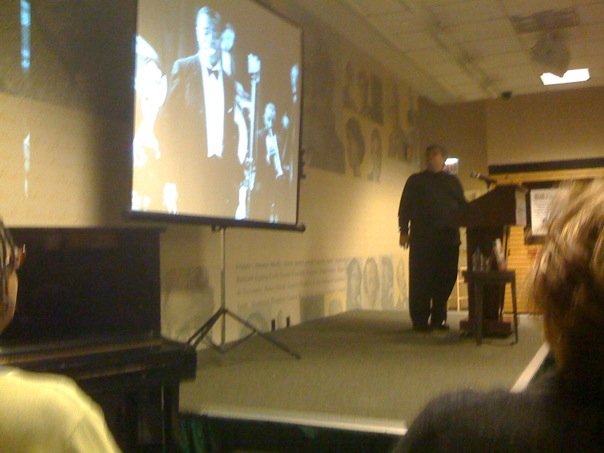 On Monday I spoke in New York about Pops: A Life of Louis Armstrong. Maud Newton, who came to hear me at Barnes & Noble Lincoln Triangle, took this snapshot as I was showing a film clip of Armstrong in action. Just before I went on stage, the folks at Houghton Mifflin Harcourt informed me that Pops has already gone into a second printing. How about that?
On Monday I spoke in New York about Pops: A Life of Louis Armstrong. Maud Newton, who came to hear me at Barnes & Noble Lincoln Triangle, took this snapshot as I was showing a film clip of Armstrong in action. Just before I went on stage, the folks at Houghton Mifflin Harcourt informed me that Pops has already gone into a second printing. How about that?
Tonight I’ll be speaking at the Los Angeles Public Library about Pops. The fun starts at seven o’clock sharp. For more information, go here.
In other Pops-related news:
• The current issue of The New Yorker contains a four-page review-essay about Pops by John McWhorter. Here’s the money quote: “Teachout excels at conveying the interplay between Armstrong the artist and Armstrong the entertainer.” The piece is only available to New Yorker subscribers on line, but you can download a podcast by McWhorter that includes soundbites from Armstrong’s private tapes–the very same ones I used in writing Pops–by going here.
• John Schaefer’s interview with me on WNYC’s Soundcheck is now available in streaming audio or as a podcast. To listen, go here.
• This touched me.
Archives for December 8, 2009
TT: For friends with big stockings
• The Bing Crosby CBS Radio Recordings (1954-56), a seven-CD box set from Mosaic, consists of 160 songs originally transcribed by Crosby for broadcast on his radio shows of the Fifties, all of them accompanied not by a studio orchestra but by an exceedingly spiffy four-piece jazz combo led by Buddy Cole, one of the top studio pianists of the day.
 Nowadays few people remember that in addition to being a consummate balladeer, Crosby was also one of the smoothest and most elegant jazz singers who ever lived. ”Bing had the best time, the absolute best time,” said the great jazz drummer Jake Hanna, who played with Crosby late in his life. “And I played with Count Basie, and that’s great time.” This set leaves no possible doubt of his urbane, unflappable swing. The superb liner notes are by Gary Giddins, whose two-volume biography of Crosby (the second installment of which will be published in 2012) promises to be definitive.
Nowadays few people remember that in addition to being a consummate balladeer, Crosby was also one of the smoothest and most elegant jazz singers who ever lived. ”Bing had the best time, the absolute best time,” said the great jazz drummer Jake Hanna, who played with Crosby late in his life. “And I played with Count Basie, and that’s great time.” This set leaves no possible doubt of his urbane, unflappable swing. The superb liner notes are by Gary Giddins, whose two-volume biography of Crosby (the second installment of which will be published in 2012) promises to be definitive.
• The Golden Age of Television, a three-DVD Criterion Collection box set, contains eight live TV dramas telecast between 1953 and 1958, including the original versions of Paddy Chayefsky’s “Marty,” J.P. Miller’s “The Days of Wine and Roses,” Arnold Schulman’s “Bang the Drum Slowly,” and Rod Serling’s “The Comedian,” “Patterns” and “Requiem for a Heavyweight.” All eight plays were rebroadcast on PBS in 1981 and later issued on videocassette, but this is the first time that any of them has been officially released on DVD. Would that the Criterion Collection had gone the extra mile and thrown in one of Horton Foote’s teleplays–I would have loved to see what “The Trip to Bountiful” looked like on TV–but even as is, The Golden Age of Television is a time capsule full to the brim of the best that live TV had to offer in its halcyon days.
TT: Almanac
“It is a great advantage to a president, and a major source of safety to the country, for him to know that he is not a great man.”
Calvin Coolidge, The Autobiography of Calvin Coolidge
